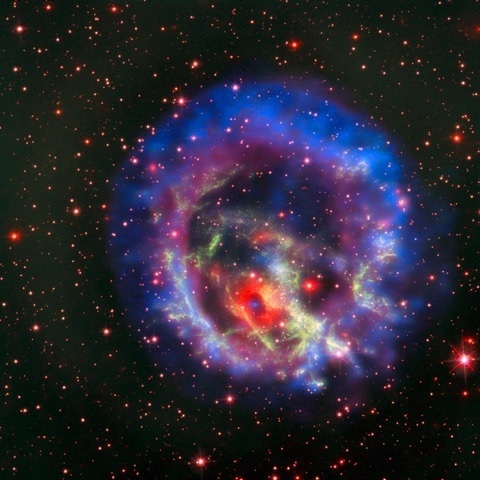Reviewed by Danielle Ellis, B.Sc.Sep 30 2024
According to a theoretical analysis by a RIKEN Physicist and two colleagues, lab experiments around the world that are preparing to recreate the enigmatic phase of matter seen in the early Universe could also produce the world's strongest electromagnetic fields. This unexpected benefit may allow physicists to explore whole new phenomena. The study was published in the journal Physical Review.
 Experiments are underway to recreate the conditions at the heart of neutron stars, such as this one discovered by NASA’s Chandra X-ray Observatory and the European Southern Observatory’s Very Large Telescope in Chile. Image Credit: X-ray (NASA/CXC/ESO/F.Vogt et al); Optical (ESO/VLT/MUSE & NASA/STScI)
Experiments are underway to recreate the conditions at the heart of neutron stars, such as this one discovered by NASA’s Chandra X-ray Observatory and the European Southern Observatory’s Very Large Telescope in Chile. Image Credit: X-ray (NASA/CXC/ESO/F.Vogt et al); Optical (ESO/VLT/MUSE & NASA/STScI)
According to the Standard Model of particle physics, when highly hot matter is compressed into an ultradense mass, it forms a plasma composed of subatomic particles called quarks and gluons. However, further research is required to verify this.
Although such expectations exist, there are huge theoretical uncertainties, especially at ultrahigh densities. Thus, experiments are greatly needed to study this extreme form of matter.
Hidetoshi Taya, Interdisciplinary Theoretical and Mathematical Sciences Program, RIKEN
In these experiments, scientists clash heavy ions or charged atoms and then study the plasma that results.
In earlier decades, these experiments primarily employed high energy to produce high temperatures, but lately, a number of global experiments have shifted their attention to intermediate energies, which will produce high-density plasmas.
This is crucially important to understand our origin since such extreme conditions are realized in the early Universe, neutron stars and exploding stars called supernovae.
Hidetoshi Taya, Interdisciplinary Theoretical and Mathematical Sciences Program, RIKEN
Taya had previously examined powerful electromagnetic fields produced by intense lasers. He concluded that an unanticipated consequence of these collision tests could be the creation of similar but much stronger fields. Since physicists believe that such ultrastrong fields would produce new phenomena in physics, this idea is quite intriguing.
However, scientists have not been able to produce fields powerful enough to test this theory until now.
Taya said, “An intense laser is equivalent to roughly a hundred trillion LEDs, but even these lasers are weak compared to the fields needed to produce these new strong-field physics effects.”
Now, Taya and associates have studied these ultrastrong fields theoretically.
We have demonstrated that electric fields, which are strong and long-lived enough to explore strong-field physics that cannot be approached with any other experiments can be produced in heavy-ion collisions of intermediate energy.
Hidetoshi Taya, Interdisciplinary Theoretical and Mathematical Sciences Program, RIKEN
However, in planned collision tests, scientists will only be able to detect the particles produced by the collision and their properties, not directly measure the produced field and thereby validate Taya's analysis.
Taya said, “To really test our prediction, it is crucial to understand how the strong electromagnetic fields affect the observable particles. We are currently working on this.”
Journal Reference:
Taya, H., et al. (2024) Estimation of electric field in intermediate-energy heavy-ion collisions. Physical Review. doi.org/10.1103/physrevc.110.014901.